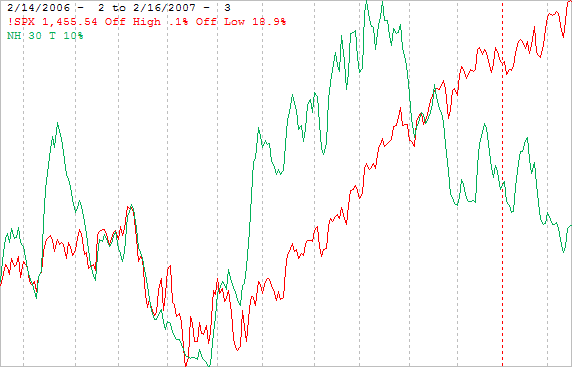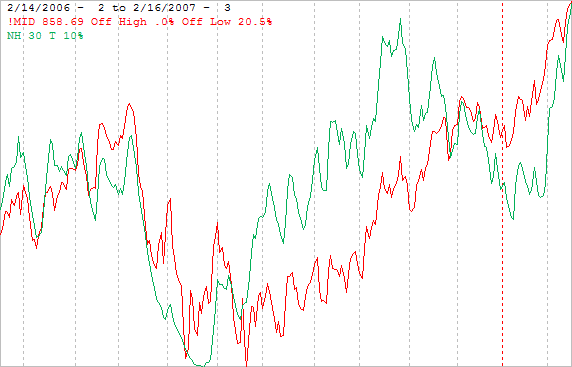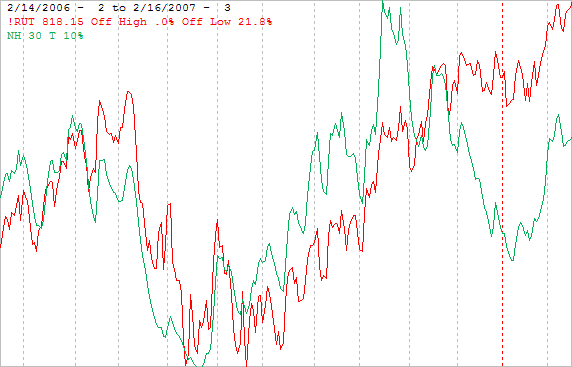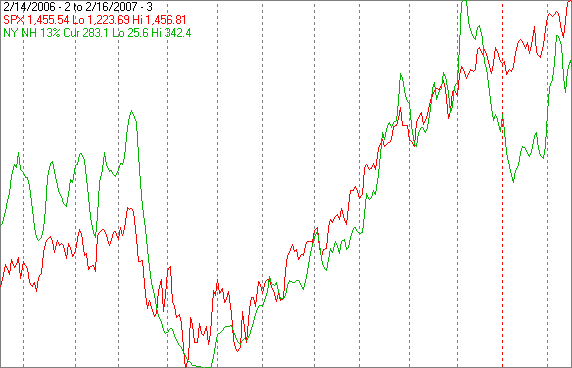Weekly Stock Market Technical Analysis Report - 17th Feb 07
Stock-Markets / Forecasts & Technical Analysis Feb 17, 2007 - 11:43 AM GMTBy: Mike_Burk
The good news is: Several of the major averages including the Dow Jones Industrials (DJIA), S&P mid cap (MID) and Russell 2000 (R2K) closed at their all time highs on Friday. New highs across the capitalization spectrum suggest there is more to come.
Short Term
Two weeks ago the MID finished a run of 10 consecutive up days. Then it fell for 2 days and resumed its upward run for another 4 consecutive days ending Friday.
Most of the major indices hit their lows for the year on January 8.
Since then the gains have been:
MID up 7.2%
R2K up 5.3%
SPX up 3.1%
DJIA up 2.8%
This is the kind of distribution of gains that you like to see in a bull market, i.e. the large caps underperforming,The drawback is that the leadership is overbought and a period of consolidation is likely.
Intermediate term
Not surprisingly, during a bull market new highs expand. One of the signs of an ageing bull market is a deterioration of new highs while the averages are rising. The implication is as the bull market ages the averages are held up by fewer of its component issues.
The charts below all cover the past year showing an index and a new high indicator (NH) which is a 10% trend (19 day EMA) of new highs.
The first 3 charts show the SPX, MID and R2K respectively with new highs calculated from the component issues of those indices. New highs have been calculated on a closing basis over the trailing 6 weeks.
The first chart shows the SPX and NH calculated from its component issues. NH peaked last October and has been falling ever since.

The next chart shows the MID and new highs calculated from its component issues. On Friday NH hit a new high for the year as the index hit an all time high. The intermediate term outlook for this index is good.

The next chart shows the R2K and new highs calculated from its component issues. NH hit its high last October, fell into early January and has been rising since its January low, but is still quite a bit lower than it was at its October high.

The next two charts are offered as a point of reference.
The first chart shows the SPX and NH calculated from new highs reported by the NYSE. The exchanges calculate new highs on an intraday basis over the trailing 52 weeks.

NH hit its high in early December and is not far from its old high.
The last chart shows the NASDAQ composite (OTC) and NH calculated from new highs reported by the NASDAQ.
 |
NH hit its high for the past year last May, a lower high in mid November and with the index slightly off a multi year high, NH is a little lower than was in November which was a little lower than its May high.

Except for the Mid caps, the new high indicators are showing some deterioration in leadership, but nothing serious at this point.
Seasonality
Next week is the week before the 4th Friday in February. The market is closed Monday in observance of Presidents Day.
The tables below show OTC data from 1963 - 2003 during the 3rd year of the Presidential Cycle and SPX data beginning with 1955.
There are summaries for both the 3rd year of the Presidential Cycle and all years combined. Data prior to 1953 has been omitted because the market traded 6 days a week.
Presidents' day often, but not always comes before the 4th Friday in February. This muddles the seasonal perspective. As you can see in the tables below there is little to distinguish the week, the OTC has been up slightly while the SPX has been down slightly.
5 days prior to the 4th Friday in February. The number following the year represents its position in the presidential cycle.
| OTC Presidential Year 3 | ||||||
| Year | Mon | Tue | Wed | Thur | Fri | Totals |
| 1963-3 | 0.45% | -0.10% | -0.29% | -0.32% | 0.00% | -0.25% |
| 1967-3 | -0.05% | 0.19% | 0.00% | 0.50% | 0.76% | 1.40% |
| 1971-3 | -1.01% | 0.04% | 0.92% | 0.59% | 0.11% | 0.64% |
| 1975-3 | -0.88% | -1.46% | 0.24% | 0.40% | 0.65% | -1.06% |
| 1979-3 | 0.00% | 0.21% | -0.26% | -0.04% | -0.33% | -0.42% |
| 1983-3 | 0.00% | -0.81% | 0.31% | 0.89% | 0.05% | 0.45% |
| Avg | -0.65% | -0.37% | 0.30% | 0.47% | 0.25% | 0.20% |
| 1987-3 | -0.48% | 0.52% | 0.87% | 0.24% | 0.70% | 1.84% |
| 1991-3 | 0.00% | 0.36% | -0.95% | 0.08% | 0.58% | 0.06% |
| 1995-3 | 0.00% | -0.30% | 0.42% | 0.43% | -0.03% | 0.52% |
| 1999-3 | 2.56% | 1.43% | -1.52% | -0.54% | -1.67% | 0.26% |
| 2003-3 | -1.97% | 0.50% | -1.90% | 1.55% | 1.03% | -0.80% |
| Avg | 0.03% | 0.50% | -0.62% | 0.35% | 0.12% | 0.38% |
| OTC summary for Presidential Year 3 1963 - 2003 | ||||||
| Avg | -0.20% | 0.05% | -0.22% | 0.34% | 0.18% | 0.24% |
| Win% | 29% | 64% | 50% | 73% | 70% | 64% |
| OTC summary for all years 1963 - 2006 | ||||||
| Avg | -0.04% | -0.34% | 0.24% | 0.10% | 0.07% | 0.06% |
| Win% | 50% | 36% | 64% | 64% | 51% | 60% |
| SPX Presidential Year 3 | ||||||
| Year | Mon | Tue | Wed | Thur | Fri | Totals |
| 1955-3 | -0.11% | 0.00% | -0.08% | -0.54% | -0.14% | -0.87% |
| 1959-3 | 0.00% | -0.07% | -0.43% | 0.18% | 0.13% | -0.20% |
| 1963-3 | 0.17% | -0.48% | -0.56% | 0.14% | 0.00% | -0.74% |
| 1967-3 | -0.56% | -0.07% | 0.00% | 0.13% | -0.05% | -0.55% |
| 1971-3 | -1.05% | 0.39% | 0.67% | 0.20% | -0.18% | 0.02% |
| 1975-3 | -1.43% | -2.35% | 1.06% | 0.50% | 1.02% | -1.20% |
| 1979-3 | 0.00% | 0.76% | -0.35% | -0.75% | -0.56% | -0.90% |
| 1983-3 | 0.00% | -1.70% | 0.90% | 1.91% | 0.09% | 1.21% |
| Avg | -1.01% | -0.59% | 0.57% | 0.40% | 0.07% | -0.28% |
| 1987-3 | -1.09% | 0.18% | 0.40% | -0.37% | 0.44% | -0.44% |
| 1991-3 | 0.00% | 0.09% | -1.15% | -0.05% | 0.19% | -0.92% |
| 1995-3 | 0.00% | 0.16% | 0.49% | 0.38% | 0.28% | 1.30% |
| 1999-3 | 2.65% | -0.07% | -1.40% | -0.67% | -0.54% | -0.02% |
| 2003-3 | -1.84% | 0.72% | -1.31% | 1.17% | 0.46% | -0.79% |
| Avg | -0.09% | 0.21% | -0.60% | 0.09% | 0.17% | -0.18% |
| SPX summary for Presidential Year 3 | ||||||
| Avg | -0.41% | -0.20% | -0.15% | 0.17% | 0.10% | -0.32% |
| Win% | 25% | 50% | 42% | 62% | 58% | 23% |
| SPX summary for all years 1953 - 2006 | ||||||
| Avg | -0.09% | -0.24% | 0.19% | -0.04% | 0.13% | -0.02% |
| Win% | 42% | 40% | 54% | 48% | 63% | 46% |
The Alpha Fund (APHAX)
The Alpha Fund, which I manage, opened last October.
Last week |
YTD |
|
APHAX |
0.5% |
+2.5% |
For information about the fund go to: http://www.thealphafunds.com/index.htm .
Conclusion
The market is overbought and seasonally next week has been flat.
I expect the major indices to be lower on Friday February 23 than they were on Friday February 16.
By Mike Burke
Mike Burk is an employee and principle of Alpha Investment Management (Alpha) a registered investment advisor. Charts and figures presented herein are believed to be reliable but we cannot attest to their accuracy. The views expressed are provided for information purposes only and should not be construed in any way as investment advice. Furthermore, the opinions expressed may change without notice. To subscribe to this report : http://alphaim.net/signup.html
© 2005-2022 http://www.MarketOracle.co.uk - The Market Oracle is a FREE Daily Financial Markets Analysis & Forecasting online publication.



